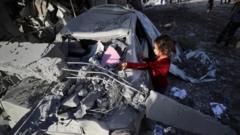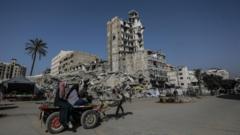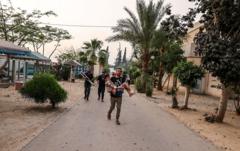Israel has unveiled plans for secure distribution centers for humanitarian aid in Gaza, as satellite images depict active construction sites. The UN and various humanitarian organizations have rejected this initiative, arguing it undermines fundamental humanitarian principles and exacerbates suffering for the civilian population.**
Israel Constructs Aid Distribution Centers in Gaza Amid Controversial Plan and UN Objections**

Israel Constructs Aid Distribution Centers in Gaza Amid Controversial Plan and UN Objections**
Satellite images reveal Israel's construction of several humanitarian aid hubs in Gaza, despite widespread condemnation and a blockade that has escalated humanitarian crises.**
Israel is undertaking the construction of several humanitarian aid distribution centers in Gaza, as confirmed by satellite images analyzed by multiple news sources. The development comes in the wake of a highly contentious plan to reroute aid deliveries following Israel's suspension of supplies to the region. Official sources within Israel indicate that the suspension, enacted in March, aims to compel Hamas to release hostages, an assertion met with condemnation from UN officials and international leaders.
The humanitarian situation in Gaza has reached critical levels, with the UN reporting that approximately 2.1 million residents face severe shortages of food, medicine, and fuel, raising concerns about a looming famine. In response, the United States has introduced a strategy that would establish a new system of aid distribution through privately managed hubs, which would operate under the protection of Israeli military forces.
Images from satellite sources indicate that preliminary construction has already begun with the clearing of land and development of access roads in southern and central Gaza. While Israel has not disclosed the precise locations of these new distribution hubs, humanitarian organizations have been briefed on plans for at least five sites, with a focus on southern Gaza.
The Gaza Humanitarian Foundation has stated intentions to provide assistance to about 1.2 million individuals, though this figure falls short of the overall population's needs. Plans for concurrent operations have been slated for launch by the end of May, with the foundation emphasizing the urgency of allowing humanitarian aid through existing channels until the new centers are fully operational.
However, the UN agencies maintain a firm stance against participating in the proposed system, asserting it contradicts the principles of impartial humanitarian assistance. A spokesperson from the UN Office for the Coordination of Humanitarian Affairs (OCHA) criticized the idea of directing aid exclusively through militarized hubs, predicting it would isolate those most in need.
Critics from humanitarian organizations, including Oxfam, have labeled the initiative as a "farce," insisting that logistical issues cannot address the broader strategy of displacing civilians or effectively combat the weaponization of hunger.
Satellite images and analysis indicate notable activity at a facility located near the Israeli Defense Forces (IDF) base, with ongoing construction of defensive measures and staging areas. Analysts highlight the design of these hubs as likely being controlled, potentially limiting access for various regions within Gaza.
The broader geopolitical context involves the newly established Morag Corridor, a military zone exerting control over Gaza. Reports of significant military operations and land clearance have emerged, raising further concerns regarding the potential humanitarian impacts on the civilian population.
As Israel maintains compliance with international law regarding aid provisions, the situation remains contentious amid the urgent calls from humanitarian organizations for open access to needed supplies and support for the beleaguered population of Gaza.






















